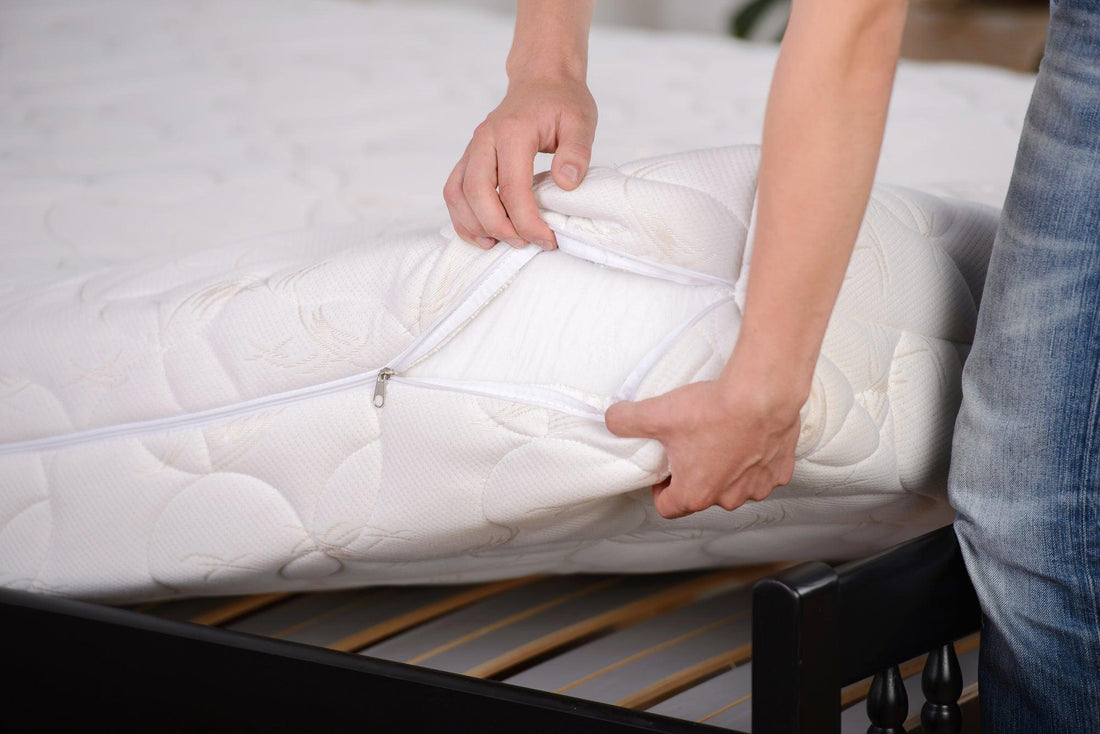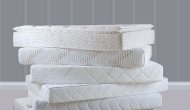How to Clean a Mattress: A Complete Guide
Did you know that you should clean your mattress at least once every 6 months? Mattresses are quite expensive so it only makes sense that you should try to make them last. Most mattresses can last around 10 years or so, but if you don't take good care of yours, it might only last a fraction of that time.
What would you do if you found out your mattress was a hotbed of health hazards? Mattresses attract and harbor bed bugs, fungus, dust mites, and more. They also soak up your sweat, skin cells, and other bodily fluids each time you lay down to rest. When your mattress is two years old, you've spent roughly 5,000 hours leaching fluids into it.
If the idea of snuggling up against a gigantic bacteria sponge doesn't sound like a restful night's sleep, it's time to learn how to clean a mattress. For allergy sufferers, a clean mattress is essential. But even if you're allergy-free, regular mattress cleaning can improve your health and extend the life of your mattress.
How to clean a mattress can seem like a serious challenge if you've never done it before. After all, you can't throw your mattress into the washing machine as you can with your bedsheets. In fact, if you clean your mattress in the wrong fashion, you can actually end up ruining it forever.
Fortunately, there are some tried and true ways that you can clean your mattress without any problems at all. Keep reading and learn more about the ways in which you can clean your mattress and why you should clean it in the first place.
Why You Should Clean Your Mattress
It might surprise you to know that most people don't clean their mattresses. This is because many people think that as long as they use a bedsheet to cover the mattress, there is no reason to clean the mattress itself. However, this is not quite true.
While it is true that a bedsheet or mattress protector can help keep your clean mattress in good shape, those protective coverings can only do so much. After sleeping on your mattress for months and years, dirt and other debris will filter through your bedsheets and reach the mattress.
Once this happens, your mattress will start to build up with all sorts of debris. In particular, mattresses love to cling to dead skin cells, hair, sweat, and dust mites. Of course, sleeping with all this grime is not a comforting thought.
The Details
If you often eat in bed, there is a chance that your mattress could be especially dirty. If food particles manage to reach your mattress, certain insects might try to make a comfy home in the fabric. If you spill any drinks on your mattress, the moisture within the fabric might start to grow mold or mildew.
This is not to mention that certain drinks like coffee or red wine can seriously stain a mattress. But sleeping on a dirty mattress is not only disconcerting but can also be harmful to your health. This is especially true if you have sensitive allergies.
Once dust, insects, and skin cells start to weigh down your mattress, you might start to experience allergy symptoms as a result. Even if you don't usually have bad allergies, an especially dirty mattress can have you sniffling and sneezing in no time. But how should you go about cleaning your mattress in the first place?
How to Clean a Mattress Like a Pro
Since most people can't afford to go about buying a mattress at a mattress sale every time their mattress gets dirty, mattress cleaning is essential. There are many mattress cleaner options available, but you will find that many of the best cleaners are already sitting around your house. In particular, you will want to have a vacuum on hand along with baking soda, warm water, a rag, and some dish soap, if necessary.
The main thing you will need to keep in mind is that you should not soak your mattress with any kind of liquid. Getting your mattress wet will ruin the stuffing on the inside. If this stuffing gets even slightly moist, there is a good chance that bacteria will start to grow and your allergies will only get worse from there.
Fortunately, most of the dirt and grime of your mattress will be on the very top layer. To start, you will want to strip your mattress of any bed sheets and mattress protectors. You will also want to wash your sheets and protectors while you're at it.
That way, when you make your bed again, everything from the mattress to the sheets will be spotless. Once you strip the bed, you'll want to assess the damage. Of course, some mattresses will be in much worse shape than others.
Step By Step: How to Clean a Mattress
Not everyone grows up learning how to properly clean a mattress. That's why we're here to break it down for you into easily approachable steps. It's best to do a deep clean of your mattress at least once a year. If you're looking for a new mattress, we recommend doing an initial clean as soon as you bring it home.
Gather Cleaning Supplies
The first thing you'll want to do is make sure you have all the necessary cleaning supplies ready. To clean a mattress you will need a vacuum, clean rags, a cleaning solution of your choice, and a hand steamer.
Strip the Bed
To get started, remove all of your pillows and bedlinens from your mattress. Make sure you have removed all top sheets, fitted sheets, and mattress protectors before you begin cleaning.
You can maximize your cleaning potential by using this opportunity to launder your bed linens. Include your sheets, blankets, duvet cover, quilt, pillowcases, and any washable pillow fillers. Make sure you read the care labels on your linens and follow the directions. To ensure the destruction of any bacteria or bugs hiding in your sheets, use hot water and set your dryer on high heat.
Vacuuming the Debris
Once the mattress is completely bare, get ready to vacuum. Vacuuming is an essential step to remove dust, hair, skin cells, and allergens from the mattress fabric. It's a good idea to go a little above and beyond by cleaning your vacuum attachments before going to town on your mattress. It will be necessary to use both the nozzle and brush attachments to get into all the crevices.
Pay extra attention to the edges and piping of your mattress.Using a small nozzle is best because it will be able to reach into any crevices that your mattress may have. Since it takes a lot of effort to clean a mattress, it's worth taking the time to be extra thorough. Keep in mind that even if your mattress looks relatively clean, there is likely a layer of dead skin and dead bugs resting on the surface.
You will want to set the nozzle to its most powerful setting. That way, the vacuum will be able to suck up any skin cells, bugs, and dust that may have dug deeper into the mattress's fabric. If your vacuum has a special upholstery attachment, feel free to use that. You also won't want to forget to vacuum the sides of the mattress. While you obviously don't sleep on the sides of the mattress, dirt and debris can still end up falling onto the sides. Dirt especially loves to crawl into the seams of mattresses.
For that reason, you will want to vacuum in a detailed fashion so you don't end up missing any big swaths of dirt and debris. Once you're finished vacuuming, your mattress should already be quite a lot cleaner. However, it likely won't be completely clean yet.
Steam Clean
When you finish vacuuming, go over the surface of the mattress with a garment steamer. The steam will aid in killing dust mites and other allergens lingering near the mattress top.
If you don't have a garment steamer, skip this step or use the steam function on your iron. Make sure not to let your steamer or iron drip on the mattress as water can cause damage.
To make sure that your mattress is spotless, you will want to go over any stains the fabric may have and remove them. While stains can be hard to remove, you'll find that removing them is much easier when you know what to do.
How to Remove Stains From Your Mattress
If there are any stains on the mattress, you should be able to pick them out pretty fast. Stains are one of the hardest things to remove from mattresses, but they are not impossible to remove.
The best way to remove a stain from a mattress is to treat it as soon as you see it. However, you likely won't even know that your mattress has a stain until much later. Fortunately, it's still possible to remove stains even if they've been sitting around for years.
Spot Clean
There are two types of stains to consider when spot cleaning mattresses: dry stains and wet stains. If your mattress has a recent stain that is still wet, clean it immediately. To spot clean a mattress, use cold water, a rag, and the cleaner of your choice. Dampen your cloth with the cleaner and blot the spill. Blotting means pressing down and releasing. Avoid Rubbing or scrubbing a stain as it will only push it deeper into the mattress fabric.
Vinegar is also effective in removing stains. To start, you'll want to get a sturdy rag along with water and white vinegar. Create a mixture that is 50% water and 50% vinegar. Then, store the mixture in a spray bottle for easy use.
Spray the stain in question with this mixture and let it sit for a few minutes. If there is any excess liquid, you can dab it with your rag. However, you should avoid scrubbing the stain with your rag. Once you spray the stain, don't forget to sprinkle a bit of baking soda on top. The baking soda will help draw out the stain.
Be sure to let the vinegar mixture and the baking soda sit on the mattress for around 8 hours. The longer you let the mixture sit, the better results you will get. After this period of time, the mixture will be dry and you will be able to vacuum the baking soda.
Once you clean the area, you should see that the stain has vanished. If there is still some trace of the stain left over, repeat the previous steps again. After battling the stain in this way for a second time, the stain should soon be invisible.
Let It Dry
Once you've spot treated all your mattress stains (no judgment, we all have them), it's time to let your mattress dry. It shouldn't take more than a few hours. You will want the mattress to be thoroughly dry before you put the clean bedlinens back on the bed.
Mattress Cleaning Methods For Specific Situations
Wine
To remove a wine stain, mix one-half teaspoon of liquid hand soap with two cups of cool water. Use a sponge to blot the stain.
Odors
Baking soda and lavender essential oil are our go-to elements for removing odors from a mattress. Mix the lavender oil into the baking soda, then sprinkle it across your bare mattress (after you've vacuumed and steamed it). Let it sit for an hour and then vacuum up the baking soda.
Urine and Sweat
To remove the stains and odors from urine and sweat, use a mixture of hydrogen peroxide, baking soda, and dishwashing soap. Put the mixture into a spray bottle and spray it across the bare mattress. Then let it air dry.
Blood
Spray hydrogen peroxide on blood stains and blot them dry with a clean rag. Then let the air do the rest of the drying for you.
Vomit
Spray a 50-50 mixture of white vinegar and water on vomit stains. Blot the stain with a clean rag and let it air dry. You can follow this up with baking soda and lavender essential oil for any residual odor.
Safe, Quality Mattress Cleaning Products
Selecting the right mattress cleaner depends on a combination of personal preference and the type of stain. For more minor stains, a natural or homemade product should work well, but you may need something stronger for stains that have set in.
Natural Products
It's always a good idea to start with the least invasive cleaning products. Natural cleaners like baking soda, vinegar, dish soap, and essential oils are the least likely to cause any unintended damage to your mattress.
Enzyme Products
For deep cleaning, an enzyme cleaner is more effective than a natural one. When all else fails, go for the enzymes.
Upholstery Cleaners
Upholstery cleaners are designed to work on a variety of different fabrics. They are great for getting out coffee, food, grease, and even make-up stains.
Why We Recommend Protection for Mattresses
One of the best ways to protect your mattress from absorbing a host of health hazards is to use a mattress protector. Mattress protectors go over your bare mattress and seal it to keep insects, fungus, liquids, and dust mites out. You won't even notice it once you put sheets on top.
Don’t Forget the Underside of the Mattress
Many people don't realize that the underside of a mattress can hold almost as much dirt and debris as the top side of the mattress. The only difference is that the underside is not likely to have any stains. Even so, it can still harbor all sorts of mites and dust that can wreak havoc on your allergies.
Once you're done cleaning the top half of the mattress, flip the mattress over and work on the other side. The first thing you should do is vacuum that entire side. Vacuuming will ensure that any dust stuck to the mattress will be removed.
You should avoid beating the mattress because that will only spread the dust around your room. Once you're done vacuuming, check for any signs of dirt or staining. If there is no more dirt that you can detect, you can declare your mattress clean.
Mattress Cleaning Matters
Most people don't spend much time thinking about the bacteria and other critters lurking inside their mattresses. Learning how to clean a mattress doesn't have to be as hard as you might expect. Hopefully, after reading this article, you're feeling more motivated to maintain a cleaner sleeping environment. Next time you clean a mattress, remember to vacuum thoroughly and use a steamer to get into all the crevices and layers of fabric.
When it's time to swap out your old mattress for a new one, entrust your sleep quality to Mattressville. Our mattress matchmaker will make sure you find your ideal mattress without the hassle.
To learn more about mattresses, contact us here, via live chat, or visit us in Mississauga near Toronto.










